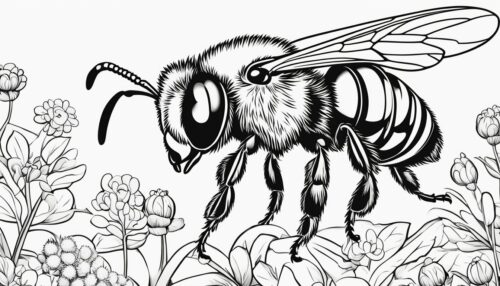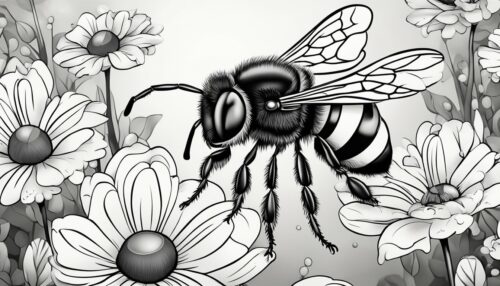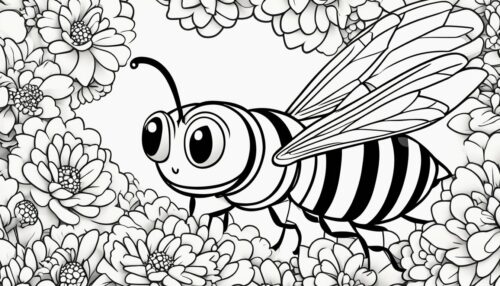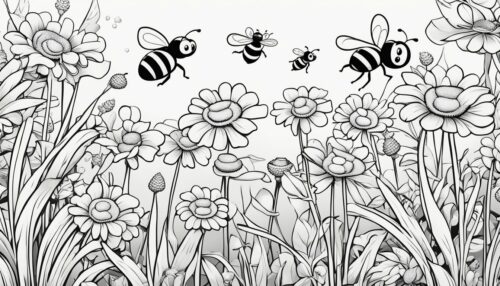Bee Coloring Pages: Fun and Educational Activities for Kids. Bee coloring pages are a fun and educational way to introduce children to the world of bees. These pages typically feature different types of bees, flowers, and other elements related to bees and their habitats. By coloring these pages, children can learn about the importance of bees in our ecosystem, how they collect honey, and how they help pollinate flowers.
Bee Coloring Pages



Some bee coloring pages may also include facts about bees, such as how many legs they have, how they communicate with each other, and how they build their hives. These pages can be a great way for children to learn about bees while also engaging in a fun and creative activity. Additionally, bee coloring pages can help children develop their fine motor skills and hand-eye coordination.

Whether you are a parent, teacher, or caregiver, bee coloring pages can be a valuable tool for educating children about the importance of bees and their role in our environment. With so many different designs to choose from, there is sure to be a bee coloring page that will capture the imagination of any child. So why not grab some crayons or markers and start coloring today?
Understanding Bees and Their Ecosystem

Bees are fascinating creatures that play a crucial role in our ecosystem. They are responsible for pollinating a large portion of the world’s crops, making them essential to our food supply. In this section, we will explore the role of bees in the ecosystem, their communication methods, and the importance of bees in maintaining a healthy environment.

The Role of Bees

Bees are known for their role in pollination. As they move from flower to flower, they transfer pollen, allowing plants to reproduce. This process is essential for the growth of fruits, vegetables, and other crops. Bees also play a critical role in the honeycomb production process. They collect nectar from flowers and use it to create honey, which is stored in the honeycomb.
Bee Communication

Bees have a unique way of communicating with one another. They use a combination of dance, pheromones, and sound to convey information about food sources and potential threats. For example, when a bee finds a food source, it will perform a dance to communicate the location and quality of the food to other bees in the hive.

Importance of Bees in the Ecosystem

Bees are essential to the health of our ecosystem. They help to maintain biodiversity by pollinating a wide variety of plants. Without bees, many crops would fail, leading to food shortages and economic instability. In addition to their role in pollination, bees also contribute to the production of honey and other products.

In conclusion, bees are a vital part of our ecosystem, and their importance cannot be overstated. By understanding the fascinating world of bees and their role in maintaining a healthy environment, we can work to protect these essential creatures and ensure their continued survival.

How to Use Bee Coloring Pages



Bee coloring pages are a great way to engage children and adults in a fun and creative activity. Here are some tips on how to use bee coloring pages effectively.
For Kids



Bee coloring pages are perfect for kids of all ages. Coloring is a great way to develop fine motor skills and creativity. Here are some tips to make the most of bee coloring pages for kids:
- Use age-appropriate coloring sheets. For younger children, use coloring sheets with simple designs and thick lines, while older children can handle more detailed illustrations.
- Provide a variety of coloring tools. Children can use crayons, markers, or colored pencils to color their bee coloring pages. Providing a variety of tools can help children explore different colors and textures.
- Encourage creativity. Let children use their imagination and creativity to color the bee coloring pages in any way they like. There are no rules when it comes to coloring!

For Adults



Bee coloring pages are not just for kids! Adults can also benefit from coloring as a way to relax and de-stress. Here are some tips to make the most of bee coloring pages for adults:
- Choose a quiet, relaxing environment. Coloring can be a meditative activity, so it’s important to choose a quiet and relaxing environment where you can focus on coloring.
- Use high-quality coloring tools. Adults may prefer to use high-quality markers or colored pencils to color their bee coloring pages. Using high-quality tools can help create a more polished and professional-looking finished product.
- Share your finished coloring pages. Sharing your finished coloring pages with others can be a great way to connect with other coloring enthusiasts and get feedback on your work.
Whether you are using bee coloring pages for kids or adults, remember that they are for personal, non-commercial use only. Printable bee coloring sheets are widely available online, and many are free to download. So, grab some crayons or colored pencils and start coloring!
Types of Bee Coloring Pages



Bee coloring pages are a fun and educational activity for kids and adults alike. These pages come in various types, each with unique designs and themes. Here are some of the most popular types of bee coloring pages:
Printable Bee Coloring Pages


Printable bee coloring pages are widely available on the internet. These pages can be downloaded and printed for free, making them a popular choice for parents and teachers. Printable bee coloring pages come in a variety of designs, ranging from simple outlines to detailed scenes. Some printable bee coloring pages even include educational information about bees, making them a great learning tool.

Bumble Bee Coloring Pages


Bumble bees are a popular subject for coloring pages. These pages often feature the classic black and yellow stripes of the bumble bee, making them instantly recognizable. Bumble bee coloring pages can be found in a variety of styles, from simple outlines to intricate designs.
Honeycomb Coloring Pages

Honeycombs are another popular subject for bee coloring pages. These pages often feature hexagonal shapes, which are the building blocks of honeycombs. Honeycomb coloring pages can be found in a variety of styles, from simple outlines to detailed scenes.
How to Draw a Bee Coloring Pages

Some bee coloring pages include step-by-step instructions on how to draw a bee. These pages are great for kids who want to learn how to draw, and they can also be used as a reference for artists who want to create their own bee illustrations.
Bee Craft Coloring Pages

Bee craft coloring pages are a fun way to combine coloring with crafting. These pages often include instructions on how to make a bee craft using materials like paper, glue, and watercolor paint. Bee craft coloring pages can be found in a variety of styles, from simple cut-and-paste activities to more complex projects.
Overall, bee coloring pages are a great way to learn about bees and their role in the environment. Whether you prefer simple outlines or intricate designs, there is a bee coloring page out there for everyone.
Benefits of Bee Coloring Pages

Bee coloring pages offer numerous benefits for children and adults alike. Here are some of the benefits of using bee coloring pages:
Learning About Bees

Bee coloring pages provide an interactive and engaging way for children to understand the importance of bees as pollinators in our ecosystem. Through coloring, they can familiarize themselves with the different species of bees, their life cycle, and the role they play in our environment. This can help instill a sense of responsibility and respect for these important insects.
Stress Relief
Coloring has been shown to be an effective stress relief technique for both children and adults. It can help reduce anxiety, improve focus and concentration, and promote relaxation. Bee coloring pages can be a great way to unwind after a long day or to take a break from a hectic schedule.
Educational Tool
Bee coloring pages can also be used as an educational tool in schools and other learning environments. Teachers can use them to supplement lessons on bees and pollination, and to spark discussions about the importance of conservation and environmentalism.
Creativity and Self-Expression

Coloring can be a great way to express creativity and individuality. Bee coloring pages offer a variety of designs and styles, allowing children and adults to choose the ones that appeal to them most. They can experiment with different color combinations and shading techniques to create unique and beautiful works of art.
Mission
The mission of bee coloring pages is to educate and raise awareness about the importance of bees and their role in our ecosystem. By providing free and accessible coloring pages, they hope to inspire children and adults to become more engaged in environmental conservation and to take action to protect these vital insects.
In conclusion, bee coloring pages offer a fun and engaging way to learn about bees and their role in our environment, while also providing stress relief and promoting creativity. They are a valuable tool for educators and parents alike, and can help inspire a sense of responsibility and respect for the natural world.



